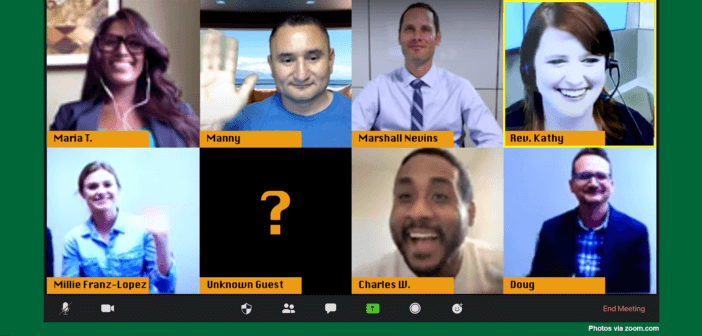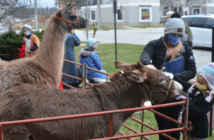Lee Roorda Schott says that unseen people you don’t yet know are likely worshiping with you online. She says this is an opportunity to enlarge our communities and offers strategies to help these digital newcomers feel included and welcomed.
You used to know who was in the worship services you were leading or attending. You could look around and you would see familiar, beloved faces. You would know, in most churches, who the “new” people were.
It’s the familiar, beloved ones we’re (mostly) lamenting right now. They’re the ones we pastors picture when we stand before a camera in an empty room. When some of us have posted pictures along our pews to represent the absent worshipers, theirs are the faces we have included.
With churches now empty and worship freshly moved online, it would be easy to focus on the ways we are in the midst (virtually) of those familiar faces. The ones whose names and stories we know. The ones that connect us to our accustomed rituals of backyard barbecues, bedside prayers, and milestones like confirmations, weddings, and funerals. We probably default to thinking of those people when we preach and when we pray.
But the truth is that there are almost certainly people you don’t know worshiping alongside you now. Moving online gives us new reach and connection. These new faces might be connected to one of those faces that are known and beloved within your church. Or they might be strangers in your neighborhood or far away who are reaching out for meaning in this season. The avenues for anyone, anywhere, to find any of us, at any time, have just multiplied exponentially.
So what if we made a point of seeing those people? Here are three key things we would do:
1. Help the new people feel welcome.
When we know we have a room full of occasional or new attenders, such as with a big family baptism or a new location launch, we do worship differently. (Or at least we should.) We welcome expansively. We don’t assume everyone knows the insider language of our longtime attenders. We go out of our way to help people know they are seen and welcomed. How does that happen online?
Name it. “I’m so glad we can gather as a church, even at a distance. I am imagining many of your faces, and I’m glad you’re here. I know there are many with us right now whom I haven’t met. I’m so glad you’ve joined us. You are welcome here.” This helps those new attenders and also the longstanding members who are apt to forget this is even happening.
Interact. Just as we would make a point of interacting with someone we didn’t know if we were together physically, we do the same online. That can come by creating a means of connection in the comments or in a “connect” form on our website or whatever is within your technology. If there is a way for people to comment, make sure we reply not just to the beloved friends whose names scroll onto our screen, but also to others whose names are unfamiliar. Don’t let their comments or questions remain unanswered, just because they aren’t attached to names and thumbnail pictures that warm your heart.
Follow up. To the extent we can capture information about someone who hasn’t been a regular part of our worshiping community, we should follow up. Never underestimate the value of a kind message that communicates that we care about a person, even someone we don’t know yet.
2. Do not assume “they” know everything “we” do.
When we all gather in one room, it feels natural to talk about some local festival, tragedy, or celebrity without explanation. We feel that people will generally know what we are talking about. When new people walk in, they are likely from the local area who know about whatever we are describing or they are visitors who will gladly enter into the spirit of what it being said.
When we don’t know who’s in the room, those expectations get stretched. Plus, as diversity increases among even our local attenders, the possibility increases that not everyone will know an event or person you mention. So, it is always a good idea to include short, gracious explanations. After you mention “Prairie Days,” for instance, you could say, “In case you’re not familiar with Prairie Days, it’s a festival here in town that happens up on the square every year in July.” You are not calling out anyone’s ignorance, and you need only a slight description — just enough to give some context for this thing that you mentioned.
The same goes for churchy words and concepts. I never mention “the Gospels” without adding something like, “those first four books of the newer testament, in the Bible, that tell about Jesus’ life and death and resurrection.” The same goes for “Lent,” or “Advent,” or, well, you get the idea. If someone new to faith will be lost without a bit of explanation, then give it. In a matter-of-fact way, with no judgment or shame. (Some of your longtime attenders will appreciate it, too.)
3. Work toward a bigger “we.”
Are you feeling the tension of my use of we in this post? I am! As if we are the ones who are offering something to them and have to accommodate them and help them feel comfortable. Ouch.
It would be easy to think of our regular, pre-COVID-19, in-person worshiping community as the we of our church. That we clearly excludes those unseen, possibly distant people who might have joined our livestream worship once or multiple times. They are welcome to join that way, but they are not in the real or imagined we that is our church.
Now, of course, this we isn’t static; there are always people coming in and out of regular attendance and membership. But still, those who have been around awhile have a sense of who we are, right? The person who has never been in worship in our sanctuary is clearly not (yet) part of us.
It cannot surprise anyone when all that feels true. As we live into a future in which in-person worship is only one of our options, though, we will need a different we. We will begin to become people who have shared worship, period. People whose names we have begun to know through prayer groups or small groups or Bible studies that discuss heavy questions in Zoom breakout rooms or in individual, caring phone calls. It’s going to stretch our brains to reimagine the scope of the we that is the church, but the time is coming, and now is, for us to let that truth settle in. With joy, actually. We are more than we thought we were!
It’s about making room for the people who are often overlooked in our communities. Those who are affected by incarceration, mental illness, trauma, violence, and poverty. Every one of those factors affects people closer to us than we realized and probably now is represented among people attending your church who wouldn’t or couldn’t show up at set times and places. I so hope our we can be big enough to encompass every one of those needs, and more.
This article originally appeared on Lee Roorda Schott’s blog. Used by permission.
Related Resources
- Preaching to an Empty Room by Alyce McKenzie
- 5 Keys to Great Online Worship Hospitality by Olu Brown
- Connecting with “Those People” by Lee Roorda Schott







